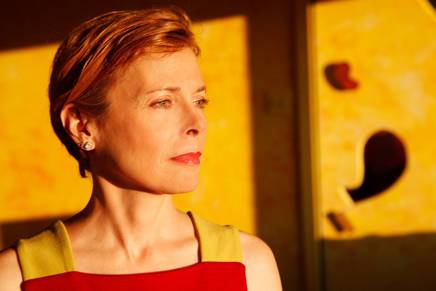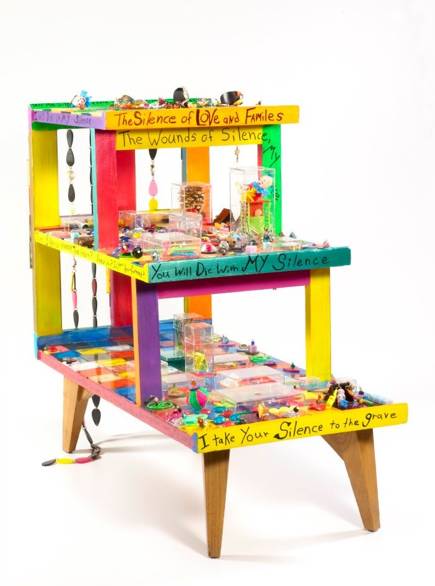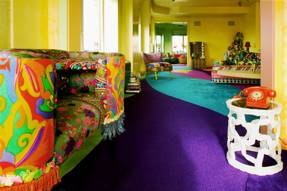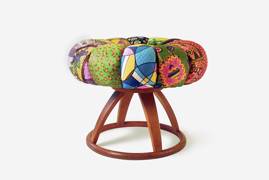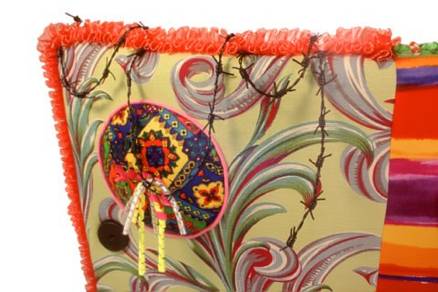

Apryl Miller
interviewed by Gregory Vincent St. Thomasino
2014
Apryl Miller
What stays is that color, that “yellow.” I wonder, the significance of this color for you, and is this your signature color and if so do you have a name for this specific color, this hue which I am here referring to as “yellow”? What stays is the impression of . . . the sun, a celebration of sunlight, of starlight, and which is life-giving, life-sustaining. The impression is of having been glissading on a beam of starlight. Immediately, my impression is that your work celebrates life, celebrates sunlight, starlight, and most necessarily celebrates the eye! It reminds me of The Beatles’ yellow submarine, that yellow does, and I think of how that yellow submarine is to the oceans as the yellow star is to outerspace, and of how we are made of that same stuff as the stars and that maybe, maybe we are destined to travel space, forever, in the form of starlight. My impression of your work is this work celebrates life!
You have guessed correctly that the color yellow has great significance for me. It is the color of hope and without it we cannot live. The absence of hope is death.
I think also, being a mother, it has been important to me to instill optimism in my children and to show them, to teach them, that they can indeed go on, when sometimes it may appear as if they cannot. I did not choose the color consciously, but rather instinctively.
It is not a particular color, or hue of yellow, any will do, that strike me as pleasing. I don’t split hairs with colors and I have no idea how to mix them to match another shade, so I’m pretty free with the way I use them. I may even begin covering a canvas with one shade of yellow and run out of it and then go to another shade to continue. It is essential to me that my work contain both the dark and the light and I do this with the use of a full, bright color palette. I think this is unusual. My paint colors are never brown, gray, white, or off whites, they are all brights, with the exception of black, which I use judiciously. Usually if black shows up in my paintings or collages, it means danger. If the light and the dark are balanced, it is the place where we feel whole. Joy resides in sorrow and loss and hope hug in the corner.
My yellow paintings did not begin until a year ago and at some point, I wrote these statements about yellow, as a poetic explanation. If there is yellow, there is light. If there is light, there is sun. If there is sun, there is hope. And, so, yes, yellow is a celebration.
“The Silence of Love and Families” 2007
wood, plastic, acrylic, metal, pinecones, Sharpie, safety pins
(25” x 14” x 29”)
Who do we wound with our silence?
Do not leave Your Love unspoken Across The Chasm, The Abyss.
No unspoken Love, My Love.
Keep Silence far from Your Heart. And I Shall: My Love.
The writing on your scultpures (why “sculptures”?), at first I wondered if this was your poetry, which is to say if this was your preferred mode of deposition . . . these messages, mottoes, proverbs, precepts, there’s something “daily prayer” about it. Why do you do this? What are we to make of these?
I wrote poetry long before I did visual work. I was a creative kid, from a creative family, but I was not an artist. That came much later. Once I began visual work, the writing remained separate, until about 10 years later. It was then that both works appeared together. When I am doing my visual stuff, I will sit working with a pencil and a BIG FAT PAD next to me and I write down all the ideas that come to me as I am painting, or drilling or what have you. I love to spread out, hence, the big fat pad. I like everything arrayed around me and I like to see everything at once. Especially as I typically work on more than one piece at a time. I like the excited chatter that goes on around me. I have a lot to say and my messages cannot be contained merely to the visual. Funny you should say “daily prayer,” as my father was a minister, and there is a lot of the pastor in me. I have some soapboxes, but I do not believe my messages are “preachy,” rather, they tell stories of redemption and they tell stories of survival skills, they are messages of sharing and messages of hope. I have a series of boxes I did called “Boxes for Hope” and this is their mantra, their daily prayer, if you will:
We need as much as we can get.
We can never give up any.
Yes we can never give too much away.
I share my beliefs, as in the piece below.
My father was powerfully gifted as a writer. He once wrote, “I discovered I had the capacity for deep passion that drove words out of my fingers like bullets.” For my offering this month, I have spliced together pieces of my father’s writings with my own. It is in a call and response style. You could say it’s a Father Daughter poem.
Father: What do you say after you’ve said goodbye?
Daughter: I believe in the Halleluiah’s of making wonder and glory spring from nothing.
Father: How to shed a tear after you’ve cried?
Daughter: I believe in how close in the heart and of the flesh two can be.
Father: What’s a noise after you’ve shouted?
Daughter: I believe that every day you should feel loved and adored.
Father: How can one trip after you’ve fallen?
Daughter: I believe in the search for the heart of miracles a hand can fashion.
Father: How can one love more, when love is so full?
Daughter: I believe when I enter a church, I don’t have to click my heels, I’m home.
Rev. Marshall Miller
Apryl Miller
May, 2013
I think I will continue to pull different statements from my work as time goes on and more of those will be brought to the fore front. They are there to be absorbed, and, yes, used by people, I write to reach people and I also write to reach myself. My work is emotional, no question. And it is very bold work, no holds barred. I am not the sort of artist people are fence sitters about. People either like my work, or they don’t. No in-betweens.
The Living Room
So. Your home is an art installation. Are you a work of art too, or do you just inhabit the place? Do you find you behave differently, inhabiting a work of art? You know, I have always felt that being in a museum, that to be immersed in an installation, in certain galleries, was a kind of like being in church. And I think it’s that way for cave art, too. The words that come to mind are transformative, generative. . . .
So, yes, my home is an art installation, but I did not know it was, until the press told me, and that was recent. Up until then, it was my personal expression in my home, my special environment I made in which to raise my children. It was conceived as a creative wonderland for their little souls to be nurtured and supported, a place where their imaginations could be unfettered. But what I did not factor in, was how it would do the same for me, too, as we lived out our lives here.
I would not say that I am a work of art, a work in progress, surely. I used to dress brighter and bolder, but as I have gotten older, I have changed my look and I am going a bit more toned down, but I would have to stop short of the word classic. It is not that I behave differently, perhaps I can’t really answer that question, not sure, have to think about it. But definitely, there is a conversation in the place which I made, that belongs to itself. What happens is when people enter the space they begin to interact with the environment and it creates a feeling of excitement, but one of peace as well. It is like an amazing grace. So I do not see it as being church like or referential, but, yes, I cannot deny it, your words, transformative, generative. This space gives back to me. And it has given back to me in many ways, one of them being the conversations that have been sparked with friends and acquaintances when they are here with me, with my family. You have to understand that I made a special home for my children, that was my simple goal. There was no grand scheme, no plan to make something that would interest the press. I was a mom making a nest for my children, and in the process I came to myself as an artist, in a really big and delightful way. So that is my story.
What influences, outside the world of art, and I’m thinking of literature, psychology, philosophy, feminism, and religion also, if you are inclined to go deeper into that, what were/are the influences that have informed your perspective, as a person, as the creative person that you are? In particular, were you ever introduced to the psychology of C. G. Jung and to his theory of dreams and their interpretation? Are you a “feminist” (is that one of your “soapboxes”?), and if so, in what sense? What motivates you as a creative person, you seem to have been, and to be, remarkably self-motivated (and certainly by your love for your family).
In terms of my influences, I have to harken back to my childhood and the way in which I was raised. I believe the deepest roots reside there, certainly with how I express myself and especially the topics of my work. I come from a creative DIY family and we had that can do attitude coupled with a belief in the miracles a hand can fashion. I was steeped in the tradition of making something your own by making it yourself. My father was a minister and we didn’t have a lot of money, but we had a lot of kids and it seems we were always making stuff and entertaining ourselves with different art projects. All our food was made from scratch and we produced both utilitarian objects and extra items, like holiday cards and Christmas ornaments.
My childhood was a lot about doing and coming from a religious background, there was an emphasis on alleviating other people’s suffering and not so much about taking our emotional temperature as a family, or as individuals. That often happens where the parents are public figures or in the helping professions. They are out tending and saving the world, but the kids just want a normal mom and dad at home. Coming from a childhood lacking in emotional acknowledgement, my adult focus is on emotional expression through doing and making. Most of my artwork is about my emotional life, relationships and the fragility of our human connections.
The seeking to express through my artwork is tied to the religious experience in my childhood. Referencing Bible verses, hymns, or even a sermon in my work is a meaningful way I touch my religion and it is important to me, that it is there, that I reference God. My focus is still attached to alleviation of suffering, but I include myself in the circle of others.
The childhood roots are deep and include literature, religion and feminism more than psychology and philosophy. Considering my soapboxes, it’s pretty much a no brainer that oppression of anyone is bad for everyone. We should all have equal rights, equal pay, access to the same health care, etc.
I am motivated to create a safe place, where we can feel our full range of emotions and therefore feel whole. By accepting our opposites, we can achieve peace, if only for brief periods of time.
And those influences directly to do with art? The artists, styles, movements, periods that have most made their impression on you and on your art and that most inspire you to make art? And your poetry? Who do you read today? Who made you want to be a poet (to be an artist)?
I don’t read much poetry. I’m in a writing group and we read and critique each other’s work, so that’s who I’m reading on a regular basis. I’m in a book club, and I read a book a month and I always read The New Yorker, but not the poetry! I’ve never understood most of it and I don’t want to work so hard to understand what I’m reading. I am very much a person who makes stuff, without having spent a lot of time studying.
Back to my childhood, my parents always read to us as children, classic children’s books, The Pooh stories, Babar, The Madeline stories, and Charlotte’s Web. There was a reverence in my family for literature and words. We were always doing word play at my house and every year my mother wrote a rhyming Christmas letter in which she detailed our families’ activities. Sometimes these were parodies of classic pieces, mainly children’s works. She and my father wrote poems for it and she would insert pieces we kids had written during the year. My mother was clever as a writer, especially with her rhyme schemes, but my father had the true gift I believe, both in prose and in poetry. I use my writing in the same way as I do my visual work. It is an expression of emotional states and of relationships. An example is when I began to write in earnest in my mid-twenties, after a failed romance. That’s when my writing began to be expressive.
In terms of the visual arts, what excites me is seeing that which I have not seen before. I want to see the new and the different.
What does it mean, to you, to one, to be taken seriously as an artist? Firstly, of course, by the art establishment, the star-making machinery, the press, but to be taken seriously by your fellow artists and perhaps most importantly by yourself? Have you ever had an “obscure” period, where you feel your art, your poetry can never be understood, can never, will never, reach anybody, not even you yourself? A period of alienation? But if a prayer is obscure, then it doesn’t work as a prayer, does it?
This is a tough one to answer. I did not come to my visual art until I was an older person and I can see myself in my work, as I progressed as an artist and as a person. There is a balance between hubris and shy and retiring I seek. I don’t want to retreat, nor beat my chest in public; it is a normal speaking voice I desire. I couldn’t sign my first works, I couldn’t take public ownership of them. Later, I could permit myself to affix my first name to my pieces, but was not ready to claim full ownership of them, nor of myself. Once I could sign my full name to my work, I began to understand the implications of lacking a name and what it takes to claim it. In order to be fully heard by myself and others, I had to stake my claim in me, in a way that was honest, not bombastic, nor fearful and retiring. The simple yet difficult part is to be oneself. Once I reached that point within, I believe my work became more accessible to others. There are dark days when climbing the ladder of oneself. I think we have this idea it is not us, but the rest of the world. The buck stops here, leaving the house to circulate, but returning back to knock on our door.
I have messages to share, messages of hope, of redemption, of survival, of love and acceptance of ourselves and each other. My prayers are still sometimes obscure, but I believe there is a God who hears us, though we cannot consistently listen.
On the subject of “art therapy.” Art as therapy. Simplifying to the extreme, art is a two-sided coin: On one side is a product that excites admiration and pleasure because of its beauty and the skill in its execution, while on the other side there is the matter of the activity in producing such a product. It is the matter of that activity that concerns us. We think of therapy as treatment intended to cure or relieve or heal—the implication is that something, someone, is unwell, unsound, disordered. The implication is that there is a lack, a lacking, a defect or deficiency. I don’t think this need necessarily be the case. (Or else, is there a need for disorder as a motive in creative activity?) What I’m thinking of is the concentration, the relaxation, the problem solving, adaptive responses, and what is involved in the hand-eye-mind coordination. The tonic effect. The restorative effect. The salutary effect. Please say, what is your understanding of art as therapy? And, for the artist generally, am I engaging in therapy when I write? Am I self-administering therapy? And if so, what does this say about me?
For myself, I think of most of my work as being therapeutic, as the majority of my expressions revolve around working through emotional states or situations. My themes are silence, tears, family relationships, difficult loves and how we treat each other as people, in general. All of this is placed under the umbrella of how we are universally imperfect. Other artists may focus on the environment, lost Indian tribes, or our relationship with food, etc., but mine is all about feelings and relationships. Examples in my work are, “The Silence of Love And Families,” “The Where And The How Left You And Your Silence,” and “The Tree And Sea of Tears… .”
Even my collage work has the same aspect, though not in what I am saying with it. It is more in the doing of it. The doing of it requires me to empty my mind and not think. I call it “Mindless Collage” because I don’t have to think, I just do and the cutting and pasting takes me to a different place, probably what you are describing as “the tonic, restorative and salutary effect.” I cannot speak for other artists, but I think if one uses their work as a tool of self-exploration, then their work is indeed therapeutic.
Probably the majority of people in psychotherapy can be classified as the “walking wounded.” They are not ill, unwell, or disordered, but they have a desire to feel better and to move beyond their childhood traumas. We all learn behaviors as children, with all of us trying to adapt to what we did not receive, with greater and lesser degrees of success. We live lives where we make the same mistakes over and over again, stuck in the hamster wheel with no relief. What we yearn for is a return to where we started, to a place where our lives were not affected by the agenda of others.
Making art, experiencing art can help us as we navigate our own seas, but I don’t necessarily feel art can heal. To have insight and knowledge is a great thing, and we can use our art to explore that, but I believe we need more than art, as I believe we need more than religion, to help us climb to a more peaceful route. To have insight is the first step, but that in and of itself is not enough to heal. How nice if it were that easy. Art, like religion, can nurture us and help sustain us, but I believe we need more than that to bring about lasting change within.
It depends on what one is writing, whether or not it is self-administered therapy. The writing may be the telling of your story, or it may be someone else’s story related to your own, or the writer may be exercising all of their skills and it is not therapy at all. Certainly it is the art of writing, the art of telling a story, the discipline of doing the work, and the studying that has led to the ability of the writer. It is the satisfaction of completing a job and knowing that it is your own unique expression, all of those things, but I’m not sure that adds up to a therapeutic experience.
How did you meet Andy Warhol? Was he at all familiar with your designs? Do you still have the piece, the footstool, he gave you? Is that the “Heywood Wakefield”? (—I have to tell you my single close encounter with Andy Warhol: It was at a James Taylor concert. I’m not sure the venue—I think it was Town Hall on 43rd. He was touring with the Dad Loves His Work album (so this was about 1981, Andy Warhol passed in 1987). I left my date to go to the bar to get drinks and as I was standing at the bar getting the drinks the song “Up on the Roof” started playing and I said I love this song and from right next to me a voice said I do too and I turned and it was Andy Warhol! And I thought, It’s Andy Warhol! I didn’t say anything I was just smiling and in my motion I made eye contact with him and I thought, That’s so cool! Andy Warhol said I do too! So that’s my single close encounter with Andy Warhol.)
Heywood Wakefield by Apryl Miller, 1998
Heywood Wakefield vintage wooden frame, vintage fabrics
(17” x 21” x 21”)
This question and the next, wherein you reference how I conceptualize my work, how there is poetry in the titles, how my work means, to see with new eyes, are closely tied. All is considered in my pieces, imagination, fabrics, veiling and unveiling, titles, and back stories. It is up to each of us, as the artist, to decide how far to go with our truth. When I do poetry readings (depending upon the type of work I am presenting, though all the work is mine), there sometimes comes a point, when I have to give a disclaimer, and I say, “I found this one day on the sidewalk and I have no idea who wrote it.”
Once, while being interviewed for a Swedish art magazine, I was asked about stories involving Alan Ginsberg, Timothy Leary, and Andy Warhol. The journalist could not recall her source, and I, not wishing my art to be about them, but about me, told her that there are such things as urban legends. And, as she pressed me further, I invoked the same statement. These were questions involving fabrics and trinkets, items I make my art with. In spite of the source of my materials, it is not about their provenance, but about the artistry of what I do and the price should not be influenced by my material’s source. Some of my work is composed of objects given to me by the nocturnal creatures and the feather covered dragon that live in my studio. Other pieces are made from treasures brought to me by the Flying Monkeys, when they stopped by my studio in midflight, to refuel on plastic bananas and coconuts. Some works are composed of beads plucked from trees, which grow in the grove of the groove of Apryl Millerness. Other items were given to me by Timothy Leary, as he looked me in the eye and said, “Don’t do anything I would do.” And I didn’t.
This idea of “Sculpture Masquerading as Furniture.” Did this just organically come into being,—that is to say, did it just suggest itself to you as you were working? Your titles, they are like stories—how you conceptualize your works!—they seem infused with so much spirit and history:
“The Silence of Love and Families.” “Evolution from the Past from which We Evolved.” “Cry Me a Circle”—is that barbed wire? “The Sun Sprouts With A Back Pocket—now, that title is a little poem!
The fabrics, and the trims, even, they are in themselves poetic, aren’t they? I’m beginning to see the practice, the art, of upholstery in a whole new light! I think if something bears the name Apryl Miller—that is what it means, to see with new eyes.
My titles can be very much like stories. Dreaming up titles can be time consuming, like any sort of writing, but I love to do it and especially love it when the title arrives on my door step, of its own volition. “Sculpture Masquerading as Furniture” arrived in that way. Initially I was trying to market them as furniture pieces, but after a time I realized they transcend furniture, because of the elements I interject, including the concepts behind them. They reside in what I call a “Teeter,” meaning they are like a see-saw in the park, sliding back and forth between art and design. They may come close to resting in one camp or the other, but they never do, as they are made to balance and hover between the two worlds. Often times there is a title, as in “Cry Me a Circle” and there is an explanatory text:
“A 1970’s Italian frame accented with dangling plastic barbed wire, “LOVE” trim and padded circles. There are full circles that pop out of the flat surface of the chair. Don’t cry me a river, who knows where it flows? Cry me a circle and all is contained, tracks of tears revolve in a circle.”
“Cry Me A Circle” detail
There are stories told through these pieces and they begin with the use of vintage garment fabrics instead of upholstery fabrics. My intention is to strip away barriers between ourselves and the objects. The fabrics have lived before making my acquaintance, and some of them are older than I am. The pieces are rendered more intimate by being covered with fabric that was intended to clothe the body. I use some furniture trims, but mainly I use trims that were made for garments. They are not made in traditional upholstery style, but rather, employing dressmaking techniques. It is as if I am clothing a body that is to be used by another body, but it is not really using, it is more of a sharing. There is an intimacy between us and in a way, I see these pieces as a metaphor for life. They present to us the unknown, in the sense that they are not expected seating pieces. They invite us to be with them and to participate in their conversation. These are some of the reasons they transcend our ideas of furniture. And, yes, everything is poetic, everything is considered, there are intimate connections to all of the materials used.
We can visit your website and we can take a tour on Flickr, but I wonder, how can we see your works in person, are you showing anywhere, is anyone carrying you? Anyone interested in purchasing, can they contact you directly?
To arrange a studio visit, please contact me directly. My studio space is located in Long Island City. Occasionally I will have pieces in shows, and I am currently waiting to hear from some shows I have applied to. I offer an artist’s talk and tour of my living space and the concepts behind it, for a fee. If you have an interest, you may email me for details and to get on my mailing list.
Thank you, Apryl Miller.
Copyright © 2014 Apryl Miller & Gregory Vincent St. Thomasino
Apryl Miller is online at AprylMiller.com
